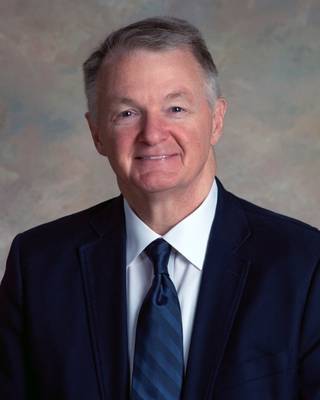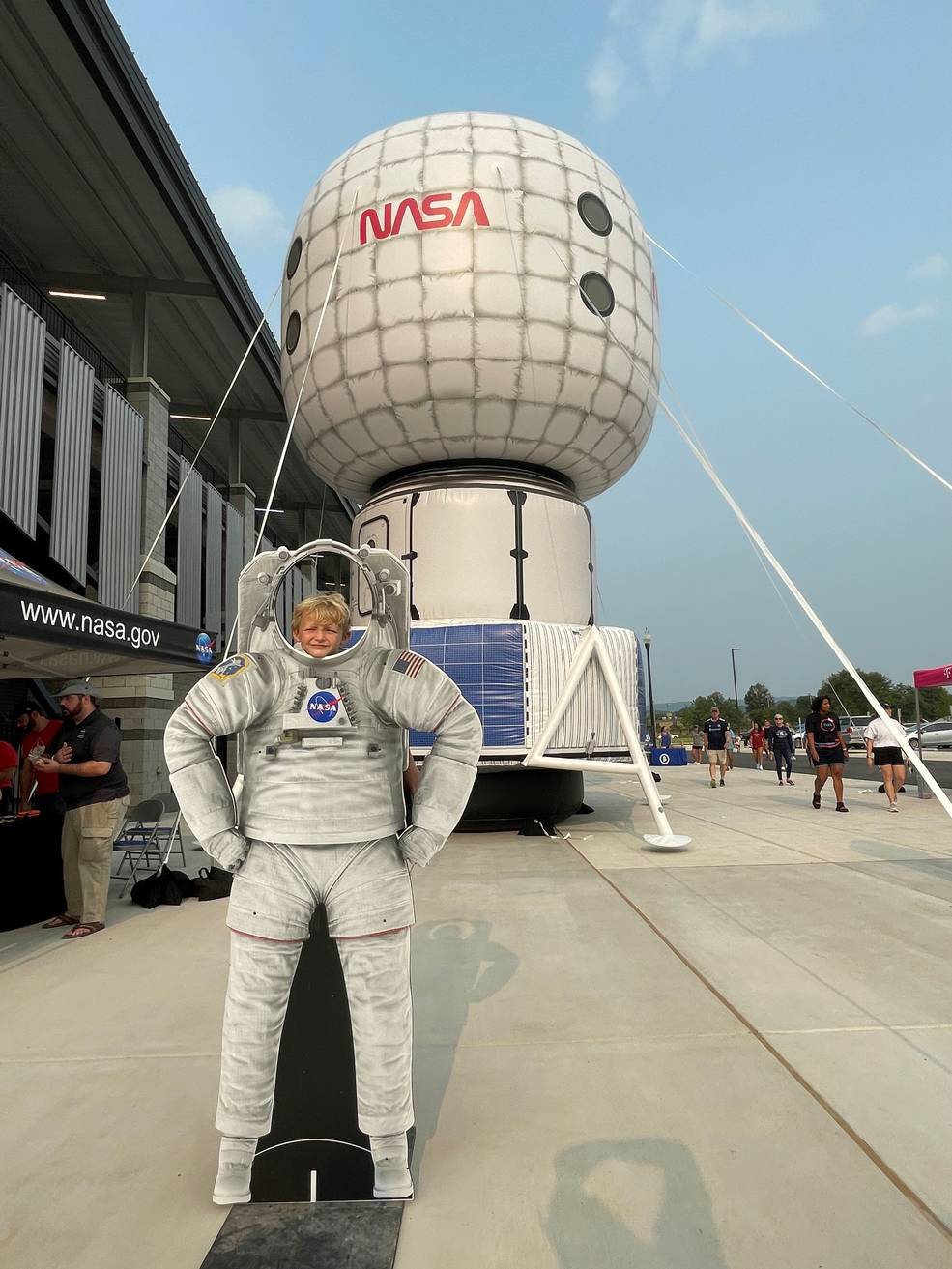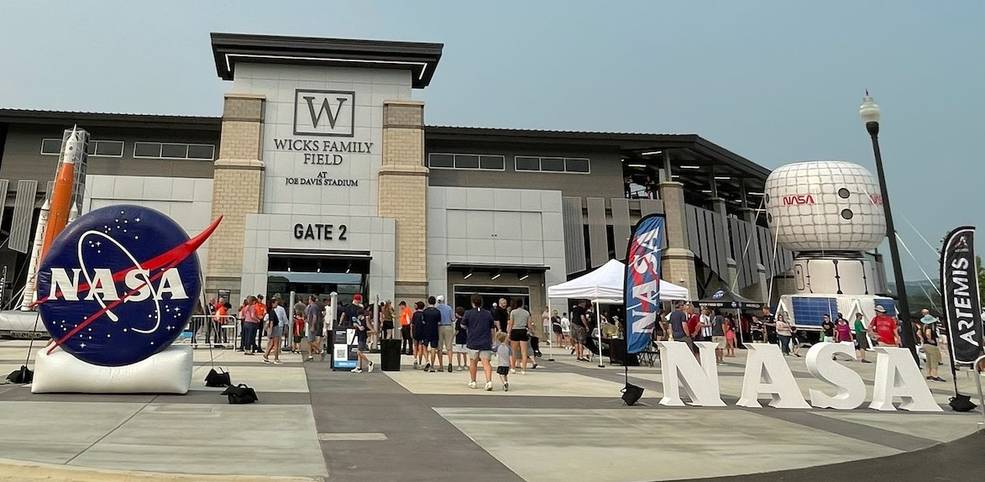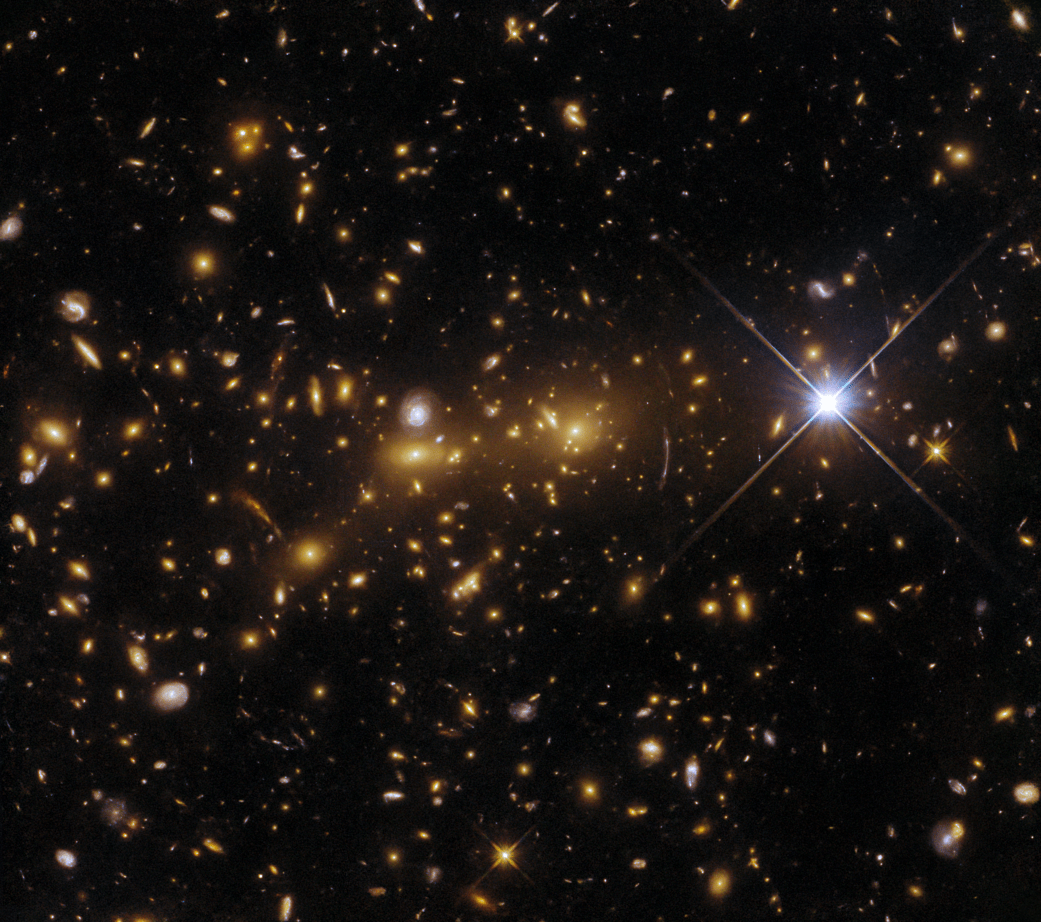The Marshall Star for July 19, 2023.
In This Week’s Star
- Marshall Director to Retire After 38 Years of Service
- Johnny Heflin Named Manager of Engines Office for SLS Program
- Marshall Center Director Honored During Space Night at Huntsville Soccer Match, Habitat Replica Debuts
- ‘Fuel’ and Fire: NASA’s Artemis Missions to the Moon, Featuring Metallica
- NASA’s Lisa Watson-Morgan Speaks at Space Camp Hall of Fame Ceremony
- IXPE Fires Up Astronomers with New Blazar Findings
- Marshall Exchange Hosts Car Show at Food Truck Corral
- Hubble Views Galactic Monster
Marshall Director to Retire After 38 Years of Service
Jody Singer, director of NASA’s Marshall Space Flight Center, has announced her intent to retire after more than 38 years of federal service that includes multiple key leadership roles at the agency.
Her retirement will be effective July 29 with Marshall’s current deputy center director, Joseph Pelfrey, serving as the interim acting director until her successor is identified through a nationwide search and open competition.
“I’ve enjoyed a long career at NASA and Marshall, starting as an intern 38 years ago,” Singer said. “The time has flown, but in looking back, we have accomplished amazing things as a team.”
As center director, Singer managed one of NASA’s largest field installations, with nearly 7,000 civil service and contractor employees and an annual budget of approximately $5 billion. Among many firsts in her career, Singer was appointed as the first female center director at Marshall in 2018, after serving as deputy director from 2016 to 2018. Her years of service and collective work culminated in the crowning achievement of her career in November of 2022 — the successful first test flight of Artemis I. This historic event restored America’s capability to send humans to the Moon, an event that has not occurred since 1972. Artemis will enable a sustained human presence on the lunar surface and will enable future human exploration of Mars.
“I truly love the NASA mission, which has been the primary reason I’ve made it my career,” Singer said. “It’s been an honor and a privilege to serve as your center director over the past five years but also working with many of you side by side, arm in arm in pursuit of our mission.”
Under Singer’s leadership, Marshall, known for its prominence in large space transportation systems, has expanded its portfolio to include human lunar landing and cargo systems, space habitation and transit systems, advanced propulsion, additive manufacturing, science payload operations, Mars ascent vehicles, and cutting-edge science and technology missions through innovative partnerships with other NASA centers, industry, government agencies, and academia. The Marshall team was critical to the successes of NASA’s Webb Space Telescope, the Imaging X-ray Polarimetry Explorer mission, the DART (Double Asteroid Redirection Test) mission, and the SLS (Space Launch System), the most powerful heavy-lift rocket ever flown to space.
“I wish Jody well during her retirement. And I know individuals at the beginning of their career at NASA – and members of the Artemis Generation who dream of working here – will be inspired by Jody’s service, knowing their contributions can help return NASA astronauts to the Moon and prepare us for crewed missions to Mars,” said NASA Administrator Bill Nelson. “And Joseph Pelfrey is no stranger to Marshall, having joined the center two decades ago as an aerospace engineer. Today, he helps guide Marshall’s broad portfolio of human spaceflight, science, and technology development, which supports missions across NASA. We are confident Joseph is prepared to guide Marshall through this transition.”
Singer joined NASA in 1985 though the professional intern program. She joined the Space Shuttle Program Office in 1986 as an engineer in the Space Shuttle Main Engine Office and was involved with Return to Flight activities after the space shuttle Challenger accident. She was the first female project manager for the Reusable Solid Rocket Booster Project from 2002 to 2007 and led the team during the shuttle Columbia Return to Flight activities. In 2008, until the shuttle’s successful retirement in 2011, she was deputy manager in the Space Shuttle Propulsion Office. Cumulatively, Singer was part of 110 space shuttle launches.
“Working in the Space Shuttle program – having been a part of over 100 shuttle launches, return to flight, and its safe fly out – Ares, and the start-up of Artemis were incredible and rewarding experiences,” Singer Said. “Most of all, I leave the federal service proud of the team, our relationships, and everything we’ve achieved together!”
Serving in roles of increasing responsibility, Singer held deputy positions for three concurrent programs, the space shuttle, Ares, and the start-up of SLS. As deputy for the Space Shuttle Propulsion Office, she guided successful fly-out and retirement of the shuttle and the transition of workforce and assets to the Ares Project Office and SLS Program. Singer was a founding member of the SLS Program in 2013. As the deputy program manager of SLS at Marshall, she helped oversee nearly 3,000 civil servants and contractors involved in the developing, testing, and certification of the rocket.
From 2013 to 2016, Singer was manager of the Flight Programs and Partnerships Office at Marshall, where she held primary responsibility for the center’s work with human advanced exploration projects, science flight mission programs, technology demonstration missions, commercial crew and International Space Station life support systems, research facilities, and payload mission operations.
She has twice been a NASA Fellow, at Pennsylvania State College and Simmons College Graduate School of Management. She is a recipient of prestigious NASA awards, such as the Space Flight Awareness Leadership Award, the NASA Exceptional Service Medal, the Silver Snoopy, and NASA Outstanding Leadership medals. She is also a recipient of two Senior Executive Service Presidential Rank of Meritorious Executive Awards. Her external recognitions include the Rotary Stellar National Award for Space Achievement, Alabama Engineering Hall of Fame, Distinguished Fellow by the University of Alabama College of Engineering, Gardner Award, AIAA Associate Fellow, 2022 Alabama Engineer of the Year, and the AIAA Herman Oberth Award.
Johnny Heflin Named Manager of Engines Office for SLS Program
Johnny L. Heflin has been named to the permanent Senior Executive Service (SES) position of manager, Engines Office, SLS (Space Launch System) Program Office. In this capacity, he is responsible for directing, overseeing, and managing contracts valued in excess of $3.2 billion, an annual budget of $500 million, and a diverse workforce of more than 1,000 civil servants and contractors at sites located across the nation.
Heflin joined NASA’s Marshall Space Flight Center in 1990 as an engineer in the Propulsion Test Division. Since then, he has served in positions of increasing scope and authority. Heflin joined the Space Shuttle Program in 2000, when he was appointed to the position of space shuttle main engine (SSME) avionics manager and later elevated to SSME hardware management and operations manager, responsible for the design, manufacturing, testing, and flight operations of flight engine hardware.
He joined the SLS Program Office in 2011 as RS-25 engine manager responsible for all operational aspects of the RS-25 liquid rocket engine. As assistant manager of the SLS Program Integration Office from 2013 to 2014, he was responsible for the integration of all programmatic aspects of the SLS Program. Heflin has served as deputy manager of the Engines Office from 2014 until 2020.
He was named SLS Engines Office manager in 2020 on a limited term SES appointment. He was responsible for leading a diverse team of more than 1,000 civil servant and contractor personnel in the development and delivery of RS-25 and RL10 liquid rocket engines for SLS, and the successful execution of the inaugural Artemis I mission.
A native of Decatur, Heflin received a bachelor’s degree in electrical engineering from the University of Alabama in Huntsville. He has received numerous awards, including the NASA Exceptional Achievement Medal, NASA Outstanding Leadership Medal, the Silver Snoopy Award, NASA Spaceflight Awareness Award, and numerous Special Service and Group Achievement awards.
Heflin and his wife, Beth, have four children and reside in Huntsville.
Marshall Center Director Honored During Space Night at Huntsville Soccer Match, Habitat Replica Debuts
NASA Marshall Space Flight Center Director Jody Singer waves to a crowd of nearly 6,000 at The Wicks Family Field at Joe Davis Stadium in Huntsville on July 16 during halftime of the soccer match between the Huntsville City Football Club and the Toronto Football Club. Singer was recognized as the “Hero of the Match,” an honor recognizing her significant accomplishments throughout her 38-year career, including serving as the first woman director of Marshall – one of NASA’s largest installations – and shepherding the successful launch of the SLS (Space Launch System) rocket for NASA’s Artemis I mission last November. Singer recently announced she would retire from the agency July 29. (NASA/Jena Rowe)
A youth attendee at Space Night, hosted by the Huntsville City Football Club, poses in a photo stand-in of an astronaut’s suit in front of an inflatable full-scale replica of a lunar surface habitat. The inflatable habitat made its debut appearance at the event. Standing 30 feet tall and 20 feet wide in the inflatable section, the structure is a concept of what a two-to-four crew member habitat may look like. In the current design, the portion of the lunar surface habitat crew would live in is a two-story inflatable, with a metal airlock below which allows crew to enter and exit from the lunar surface. Marshall has supported tests with commercial partners Lockheed Martin and Sierra Space, along with NASA’s Johnson Space Center, to advance inflatable habitat technology in support of Artemis lunar missions. (NASA/Janet Sudnik)
Marshall team members supported Space Night. Marshall staffers displayed exhibits and distributed outreach materials while discussing the successes of the SLS rocket and NASA’s future lunar exploration missions through the Artemis program. (NASA/Jena Rowe)
‘Fuel’ and Fire: NASA’s Artemis Missions to the Moon, Featuring Metallica
What do Metallica and NASA’s Artemis missions to the Moon have in common? Both love “Fuel” and fire. See footage of the Artemis I launch scored by Metallica’s “Fuel.” Learn more about how NASA’s SLS (Space Launch System) rocket and Orion spacecraft will send four astronauts on a lunar flyby around the Moon for NASA’s Artemis II mission. (NASA/Brandon Hancock and Sam Lott)
NASA’s Lisa Watson-Morgan Speaks at Space Camp Hall of Fame Ceremony
Lisa Watson-Morgan, program manager for NASA’s Human Landing System, shares the agency’s plans for future lunar exploration through the Artemis program with a crowd of more than 500 during the annual Space Camp Hall of Fame Dinner at the U.S. Space & Rocket Center on July 14. Four new members were inducted into the Space Camp Hall of Fame at the event attended by NASA and aerospace industry leaders. Space Camp began in 1982 and has since shared space, science, and rocketry content with more than 900,000 trainees. (NASA/USSRC)
IXPE Fires Up Astronomers with New Blazar Findings
The universe is full of powerful supermassive black holes that create powerful jets of high-energy particles, creating sources of extreme brightness in the vastness of space. When one of those jets points directly at Earth, scientists call the black hole system a blazar.
To understand why particles in the jet move with great speeds and energies, scientists look to NASA’s Imaging X-ray Polarimetry Explorer (IXPE), which launched in December 2021. IXPE measures a special property of X-ray light called polarization, which has to do with the organization of electromagnetic waves at X-ray frequencies.
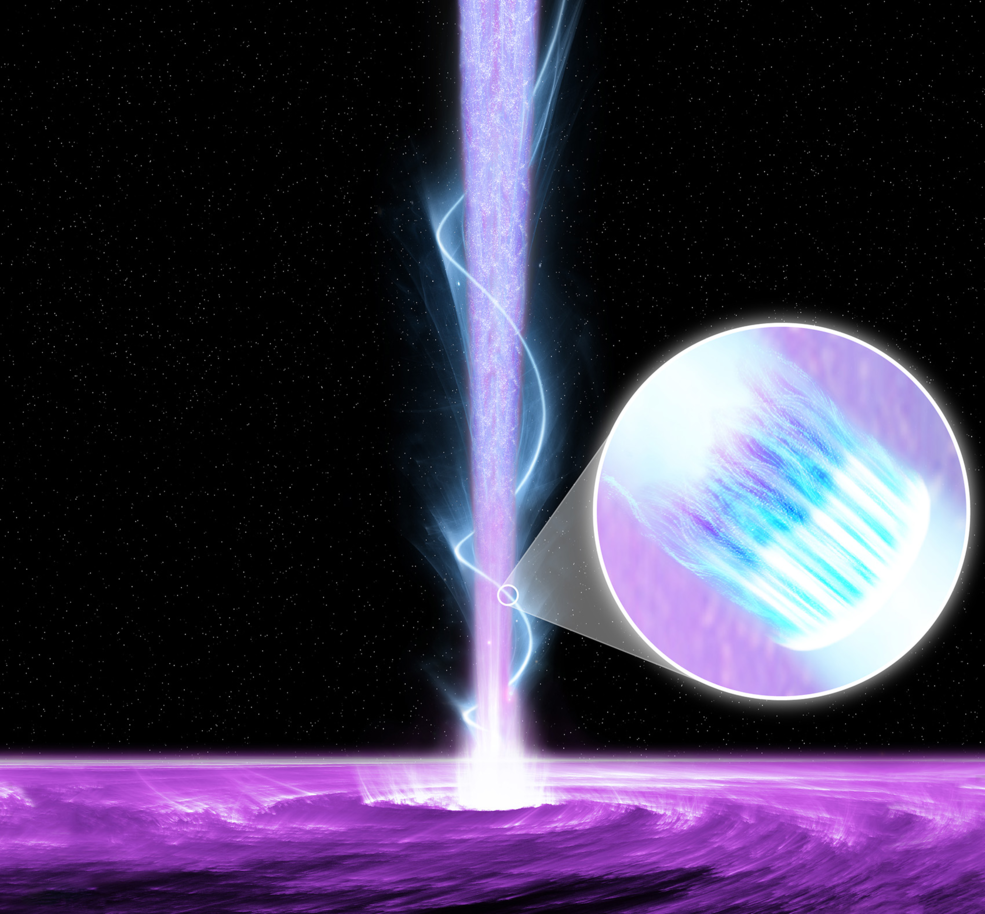
This week, an international team of astrophysicists published new findings from IXPE about a blazar called Markarian 421. This blazar, located in the constellation Ursa Major, roughly 400 million light-years from Earth, surprised scientists with evidence that in the part of the jet where particles are being accelerated, the magnetic field has a helical structure.
“Markarian 421 is an old friend for high-energy astronomers,” said Italian Space Agency astrophysicist Laura Di Gesu, lead author of the new paper. “We were sure the blazar would be a worthwhile target for IXPE, but its discoveries were beyond our best expectations, successfully demonstrating how X-ray polarimetry enriches our ability to probe the complex magnetic field geometry and particle acceleration in different regions of relativistic jets.”
The new study detailing the IXPE team’s findings at Markarian 421 is available in the latest edition of Nature Astronomy.
Jets like the one beaming out of Markarian 421 can extend millions of light-years in length. They are especially bright because as particles approach the speed of light, they give off a tremendous amount of energy and behave in weird ways predicted by Albert Einstein. Blazar jets are extra bright because, just like an ambulance siren sounds louder as it approaches, light pointed toward us also appears brighter. That’s why blazars can outshine all of the stars of the galaxies they inhabit.
Despite decades of study, scientists still don’t fully grasp the physical processes that shape the dynamics and emissions of blazar jets. But IXPE’s groundbreaking X-ray polarimetry – which measures the average direction of the electric field of light waves – gives them an unprecedented view of these targets, their physical geometry, and where their emissions originate.
Research models for the typical outflow of the powerful jets typically depict a spiraling helix structure, similar to the way human DNA is organized. But scientists did not expect that the helix structure would contain sites of particles being accelerated by shocks.
IXPE found surprising variability in the polarization angle during three prolonged observations of Markarian 421 in May and June 2022.
“We had anticipated that the polarization direction might change but we thought large rotations would be rare, based on previous optical observations of many blazars,” said Herman Marshall, research physicist at the Massachusetts Institute of Technology in Cambridge and a co-author of the paper. “So, we planned several observations of the blazar, with the first showing a constant polarization of 15%.”
Remarkably, he added, initial analysis of the polarization data from IXPE appeared to show it dropped to zero between the first and second observations.
“Then we recognized that the polarization was actually about the same, but its direction literally pulled a U-turn, rotating nearly 180 degrees in two days,” Marshall said. “It then surprised us again during the third observation, which started a day later, to observe the direction of polarization continuing to rotate at the same rate.”
Stranger still was that concurrent optical, infrared, and radio measurements showed no change in stability or structure at all – even when the polarized X-ray emissions deviated. That meant a shockwave could be propagating along spiraling magnetic fields inside the jet.
The concept of a shockwave accelerating the jet’s particles is consistent with theories about Markarian 501, a second blazar observed by IXPE that led to a published study in late 2022. But its cousin Markarian 421 shows more clearcut evidence of a helical magnetic field contributing to the shock.
Di Gesu, Marshall, and their colleagues are eager to conduct further observations of Markarian 421 and other blazars to learn more about these jet fluctuations and how frequently they occur.
“Thanks to IXPE, it’s an exciting time for studies of astrophysical jets,” Di Gesu said.
IXPE is a collaboration between NASA and the Italian Space Agency with partners and science collaborators in 12 countries. IXPE is led by NASA’s Marshall Space Flight Center. Ball Aerospace, headquartered in Broomfield, Colorado, manages spacecraft operations together with the University of Colorado’s Laboratory for Atmospheric and Space Physics in Boulder. IXPE’s observations of Markarian 421 were complemented with data gathered by partner observatories across the United States and in France, Japan, Spain, and Crete.
Marshall Exchange Hosts Car Show at Food Truck Corral
Will Bryan, SLS (Space Launch System) communications strategist at NASA’s Marshall Space Flight Center, stops by an IndyCar Series show car on display July 12 at a car show hosted by the NASA Marshall Exchange atthe food truck corral. (NASA/Eben Boothby)
Redstone community members look over some of the cars and trucks on display at the car show. (NASA/Eben Boothby)
Hubble Views Galactic Monster
The NASA/ESA Hubble Space Telescope has captured a monster in the making in this observation of the exceptional galaxy cluster eMACS J1353.7+4329, which lies about eight billion light-years from Earth in the constellation Canes Venatici. This collection of at least two galaxy clusters is in the process of merging together to create a cosmic monster, a single gargantuan cluster acting as a gravitational lens. Gravitational lensing is a dramatic example of Einstein’s general theory of relativity in action. A celestial body such as a galaxy cluster is sufficiently massive to distort spacetime, which causes the path of light around the object to be visibly bent as if by a vast lens. Gravitational lensing can also magnify distant objects, allowing astronomers to observe objects that would otherwise be too faint and too far away to be detected. It can also distort the images of background galaxies, turning them into streaks of light. The first hints of gravitational lensing are already visible in this image as bright arcs which mingle with the throng of galaxies in eMACS J1353.7+4329.
The data in this image are drawn from an observing project called Monsters in the Making, which used two of Hubble’s instruments to observe five exceptional galaxy clusters at multiple wavelengths. These multi-wavelength observations were made possible by Hubble’s Wide Field Camera 3 and Advanced Camera for Surveys. The astronomers behind these observations hope to lay the groundwork for future studies of vast gravitational lenses with next-generation telescopes such as the NASA/ESA/CSA James Webb Space Telescope. NASA’s Marshall Space Flight Center was the lead field center for the design, development, and construction of the space telescope. (Text credit: European Space Agency (ESA). Image credit: ESA/Hubble & NASA, H. Ebeling)






























